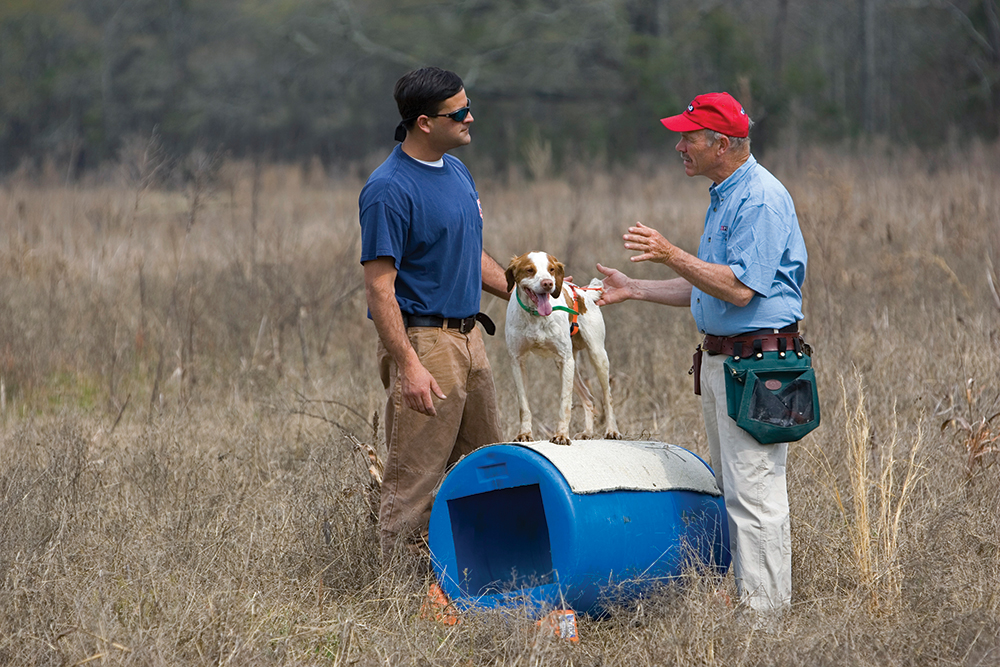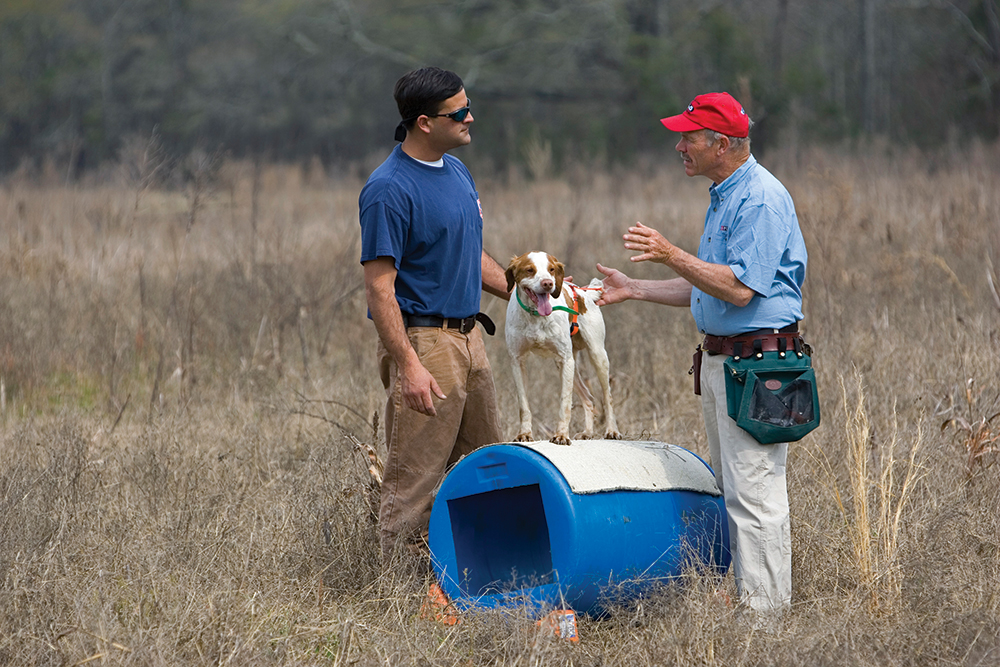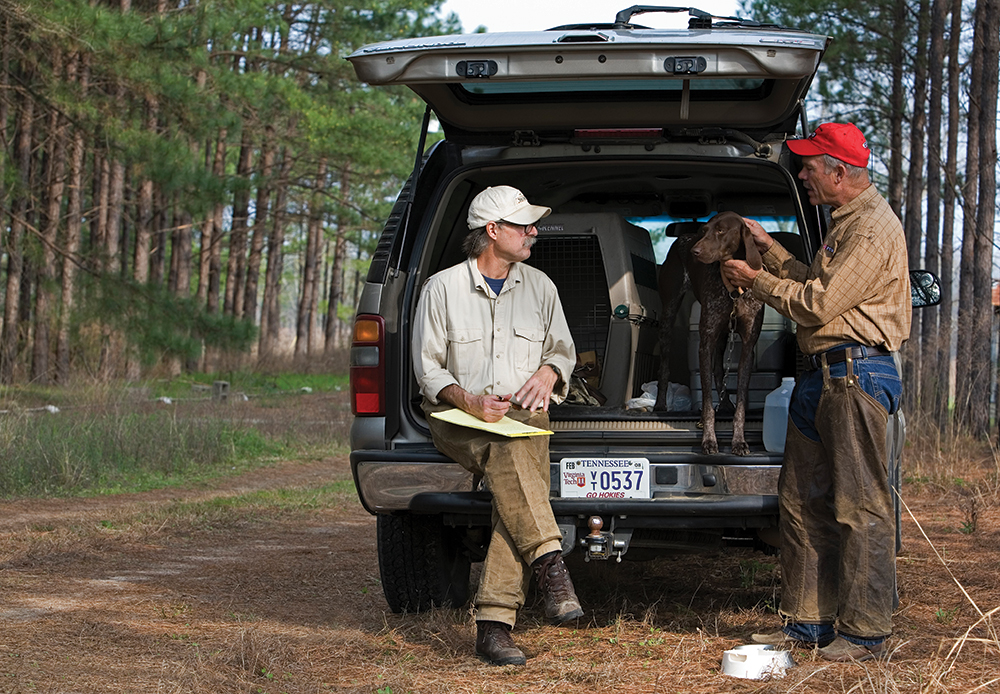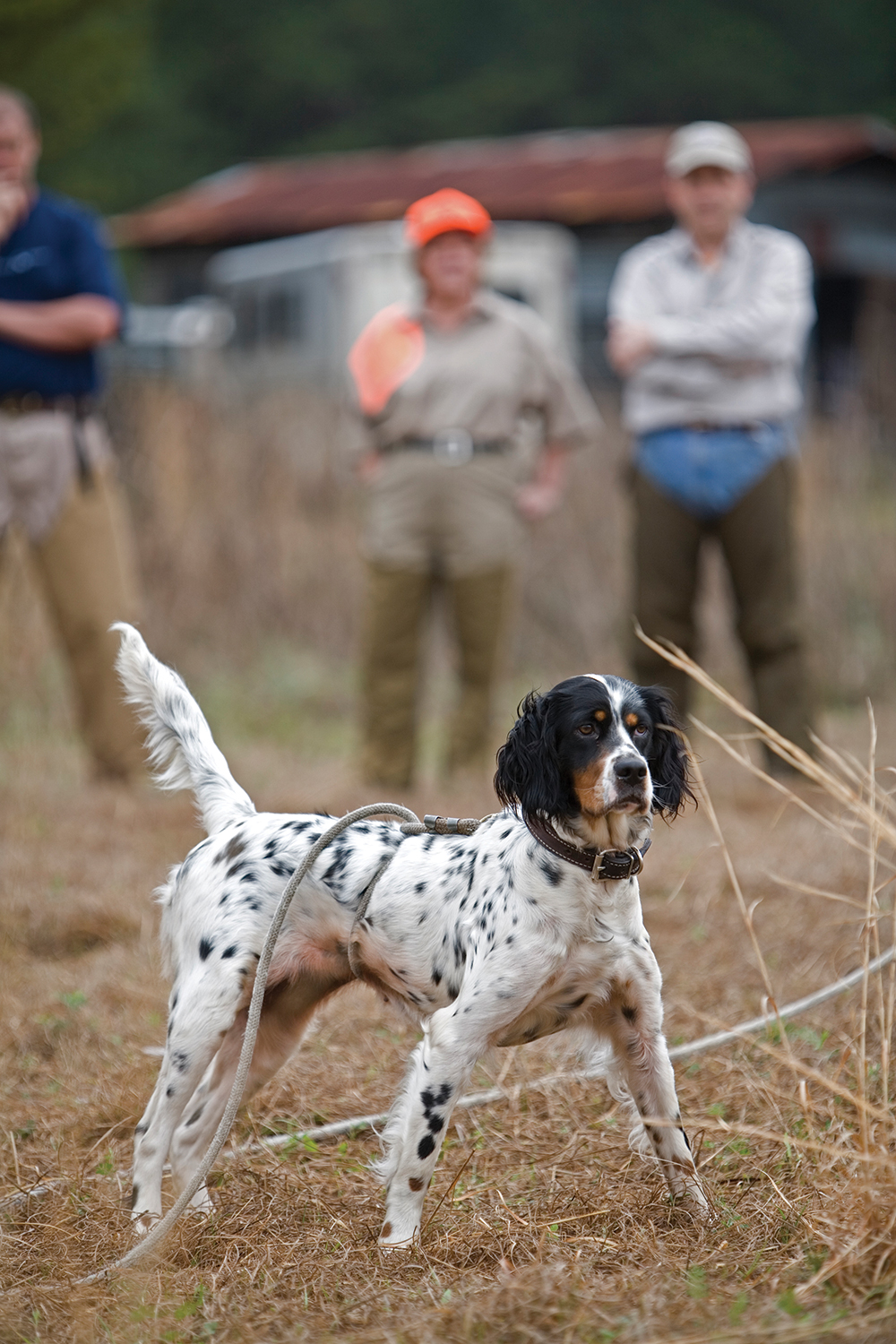Compliance with Style

George Hickox and I have been friends ever since we met at a trade show and decided we each had something the other could use: I needed top-notch dogs to photograph, and he needed pictures for promotional materials and articles. George Hickox is a world-renowned dog trainer, writer, and jack of all trades. He has devoted more than two decades of his life to raising and training great bird dogs. Hickox has won many accolades, including training and campaigning National High Point Champions and numerous Field Champions.
Thousands of people have profited from his training camps, videos, experience, and knowledge—including me. Over the years we’ve spent a lot of time together—on photo shoots, hunts in South Dakota, Georgia, and Alaska, and at his training schools around the country. And as far as I can see, taking it easy doesn’t seem to be part of his genetic makeup, even while approaching 70.
Hickox’s success in field trialing and his subsequent career as one of the country’s top sporting dog trainers, as well as writing on the subject for magazines such as Shooting Sportsman, Pheasants Forever, and the Pointing Dog Journal made him the perfect candidate for training my dogs and many others over the years.
I’ve owned three hunting dogs in my life: Sparky, an English pointer and hard-luck rescue case; Jimmy, another pointer I had from 7 weeks to well into his 14th year; and Annie, a sweet but soft yellow Lab that required lots of positive reinforcement to become the confident, happy dog she is today.
Soon after Sparky showed up at the Gallatin Field Airport in Bozeman, Montana, I quickly found out why this skinny dog had ended up lost on a highway, no doubt far from home. He was wild and excitable, with a knack for exploring country far and wide without me. Unfortunately for the both of us, the advice I received from a friend and self-proclaimed dog trainer, although well-meaning, turned out to be ill-informed, and Sparky and I suffered for it.
By the time I brought Jimmy home, I’d at least read up on raising a bird dog, but I still had little idea what I was doing. Although his last six years were a cakewalk, the early years had their ups and downs, the downs resulting from my bad temper and ignorance of dog behavior, the ups from Jimmy’s natural abilities and the little information I’d started collecting during my first years photographing George Hickox’s dogs almost two decades ago.
Annie, it seems, is my redemption. She got the better end of the bargain the moment she became part of my family. She arrived, it seems, after I’d spent enough cumulative days observing Hickox training dogs and dog owners that I finally had enough knowledge to deal with her problems. For once I was the guy doing her right, in no small part thanks to Hickox spending a few hours with Annie and me while he was in Montana training dogs one summer, and then suggesting a course of action.
During the next nine months it was exhilarating to affect a dog so positively, to have even Hickox say, one year later, “Wow, that’s a totally different dog than the one I saw last year.” Quite a compliment coming from him.

I was thinking about my transition as a dog owner during a recent training school George Hickox conducted near my home this past June. Two things struck me during his introductory remarks: First, as at most of his schools, the attendees’ levels of experience were as varied as the breeds of dogs they owned. Some had little to no dog training under their belts; others had formerly attended Hickox schools and were shoring up their training knowledge. Second, no matter how many times you listen to Hickox—and I’ve spent a lot of time with him—you’ll never fail to be impressed with his knowledge of canine behavior and his ability to convey that knowledge intelligently and concisely. Fact is, if there’s anyone out there who knows more about dogs, I’d be surprised.
What separates trainers like Hickox from the rest of the crowd is his ability to think outside the box to solve a dog’s problems, and his willingness to try new methods, specific to sporting dogs or not. I remember his excitement a while ago when he was introduced to the benefits of clicker-training puppies by someone who trained problem pets, now one of the foundations of Hickox’s program. As he’s quick to point out, the task might change, but how a dog learns is the same—whether it’s a bird dog, a protection dog, or just a family pet.
Part of Hickox’s introduction to training is to get students to realize that a dog is motivated not by pleasing his owner but by pleasing himself, and good training must acknowledge that. It’s something of a tough love lesson for many first-time students who imbue their favorite pets with more noble sensibilities.
“We want to make sure the dog completely understands what works for him and what doesn’t,” says Hickox. “Since a dog is motivated by self-interest, he needs to perceive a command or desired behavior as something that works for him. I don’t care about his understanding what works for me. Yes, certain things work for me and others don’t, but I want the dog to perceive what works and doesn’t from his perspective. And if he figures that out, he’s going to make the right choice.”
At the heart of Hickox’s training method is the belief that the less pressure you put on a dog, the better and more stylish that dog is going to be. It boils down to one of Hickox’s favorite catchphrases: “compliance with style.”
“In the past,” Hickox says, “I probably used more pressure, or more frequent pressure, than I do now. I still believe in correction at the right time, but I’m less pressure oriented and more program oriented now. Laying a solid foundation and not having unrealistic expectations about how a dog should perform is important. I guess you’d say these days I have more patience. That’s some of the best advice I can offer: Be realistic and don’t rush the process. If you don’t develop a solid foundation by doing your yard drills and making sure your young dog succeeds at those first, you’re guaranteed failure in the field. You’ll have to apply more pressure to get the dog to do what you want, all of which will result in a less confident and less stylish dog. Most top field-trial dogs are 4 to 8 years old, with lots of training behind them.”
One of the biggest influences on Hickox’s training methods came about as a result of his teaching clinics. “Everybody makes mistakes, even pros. But during my clinics I saw a pattern of consistent mistakes that handicap a dog from being able to learn. Those would be variable reinforcement, or inconstancy by sometimes correcting a dog for some behavior and other times not; rewarding a dog for no reason at all; and saying a command multiple times. So when an owner finally decides he wants his dog to comply, he has to put a lot more pressure on him.
“Laying a foundation with clicker work, for instance, teaches a puppy how to learn and gives it a good attitude about going to school,” Hickox says. “If you just bring a dog in and start jerking his head around for not whoaing, well hell, he is not going to want to go to school. He’d rather do something else. I want a dog that thinks, What are we going to learn now? I don’t know what it is, but I bet it’s going to be fun.”
Hickox stresses the importance of communicating to your dog why he’s getting rewarded or corrected. “When you put pressure on a bird dog and he doesn’t know why, it’s disastrous. He’s either going to run away, quit, or become apprehensive or case-hardened. None of those gives you a better student, and it makes your job as a trainer harder. So many times the owner knows why he corrected or rewarded, but the dog doesn’t have a single clue.
“What I tell my students is you’re not paying me for the field trial successes or high-point dogs I’ve been fortunate to have. You’re paying me for all the dogs that were good enough but failed to make it because I made mistakes.” Hickox continues, “If I can help owners prevent making mistakes, they’ll be far better off. Fixing mistakes is the hard part.”

It might surprise many of Hickox’s dog school acolytes that what kick-started his lifelong love affair with stylish, well-bred pointing dogs was a mutt named Bugle.
“My grandfather bought him for five bucks when I was six, and growing up in Greenville, South Carolina, where the streets were no fun for me. I gravitated toward the surrounding tenant farms with their hedgerows and soybean patches and quail. I had no clue where he was during the day, but when the school bell rang, Bugle would be by my bike, and off we’d go. We hunted almost every day, and he racked up a lot of experience. You couldn’t tell me he wasn’t the world’s best dog.”
That dog led to more, and eventually to Hickox entering field trials in the late 1970s, and giving up a career in commercial photography to pursue field-trialing full-time at age 38. Although he started field-trialing springer spaniels, his passion for pointing dogs eventually won out.
“I still love springers, but there’s something about pointing dogs’ intensity on point, their running style and athleticism. It doesn’t matter whose it is, but when I see a dog perform well and slam on point, I still get goosebumps. I guess the day I lose interest is the day I should hang up my spurs and sell my saddle.”
As a self-professed field trial junkie, Hickox had considerable success with a couple of high-point dogs, and numerous wins. But what steered him away from the circuit and into training dog owners was his kids.
“I would be in Texas one weekend, Alberta the next, then Illinois, and I wasn’t seeing my kids. I wasn’t there for my daughter’s fiddle concert or my son’s Little League games. So I decided to take two years off and be a better dad, fully intending to return. My friend Dave Meisner, founder of Gun Dog magazine, The Pointing Dog Journal, and The Retriever Journal, asked what I was going to do in those two years, and frankly I didn’t have a clue. That’s when he suggested running dog training clinics. He set one up in conjunction with a hunt he was hosting at the Flying B Ranch in Idaho.
“It turns out I really loved it. The people and dogs were great, and I felt I really helped them. And I had something of a revelation. I had been so focused on winning—and only winning—yet I felt I had just won a blue ribbon helping folks enjoy their dogs more. That was the catalyst for the training schools, and since to be competitive in field trialing you have to do it full-time, I decided to stick with training and the schools, as well as guiding hunts in Georgia, the Dakotas, and Alaska. Eventually I got involved a lot with training dogs with the Special Forces.”
That affiliation with Special Operations Forces has been going on for more than a decade. “The canine program there is all about the dogs assisting military personnel and helping them to do their jobs and come back safely. The dogs are trained to find IEDs and explosives caches, as well as handle enemy combatants who pose a threat to our troops. It’s a program where, unlike a bird dog breaking point, anything short of 100 percent compliance could result in disaster. I’ve really enjoyed that part of my career; it’s been a huge honor to work with these outstanding and dedicated people and those phenomenally athletic dogs.”

While we may love our current dogs, there’s always that one dog we remember most fondly. Even people who have known Hickox for a long time might assume that working with so many talented dogs over the years would make him a bit jaded. But it didn’t take long for him to name his favorites, or to credit them for being some of the highlights of his career.
“Swaps, a springer spaniel, was one of the most talented and athletic dogs I’ve ever had. I owe Swaps a tremendous amount of gratitude, because he was so good he made me think I was a trainer. He was tremendously consistent, a multiple high-point dog. I’d been field trialing other dogs, but when I got Swaps, he set us on a whirlwind tear of consistent placements over seven years.
“Then there was Laddie, a setter who, as much of a handful as he might have been as a youngster, was phenomenal when he settled in. You could always count on him. One time I lost Laddie on a Georgia horseback hunt. I looked for him for about an hour and finally found him, on point, buried in thick cover, and the covey was still there. What a performance!”
But perhaps Hickox’s favorite dog of all—certainly my favorite photography subject at the time—was Broadway, a sweet, powerhouse liver-and-white pointer. “Broadway could hunt anything and yet sit in the front seat of the truck,” Hickox says. “He’d stand there with the same intensity 45 minutes after he first went on point. You could run him big in Alaska, or tight in the grouse woods. He always performed like a star. And he didn’t have a mean bone in his body. At night he’d be sure to be sitting by my side.
“One of the highlights of my career took place in Alaska. Broadway went on point about a mile out. When we finally got there and walked by Broadway to flush the ptarmigan, the birds got up and my clients each shot one. When I turned around to release Broadway, his nose was full of porcupine quills, which weren’t there when we walked by him.
“He was on point next to a small willow thicket, and there happened to be a porcupine in there that must have slapped him when we went by or when the guns went off. And yet he held point and never wavered. That was one helluva dog. Those are the sorts of things I think about when I sit in my chair outside having an evening cocktail.”
I used to think a lot about Hickox’s dogs whenever I’d return home after days of photographing them. They were everything I could have imagined when looking at those fine oil paintings depicting setters or pointers locked on a grouse or covey of quail—except better. Twelve o’clock tails, no signs of creeping, all muscle and sinew, noses snuffling scent. Flesh and bone. Fair to say I often returned home with a serious case of dog envy despite loving my own dogs. Lucky for me, I knew deep inside that owning a dog of that caliber would constitute a crime. As a hunter, I’m a generalist; for much of the season I’d be hunting something other than upland birds. It really would be a waste of all that raw talent and expert training.
Yet nothing dampens my thoughts after attending a Hickox dog clinic. After one of his clinics, I feel hopeful and empowered and I realize how a dog thinks and learns and know I have enough tools to train one right. When I get my next opportunity to start over from scratch, I know I’ll do it right. I’ll be able to look back some day and remember training a dog with absolutely no regrets—a huge accomplishment in itself.


Originally published in Volume 6, Number 1 (Dec-Jan 2018) of Covey Rise.
























